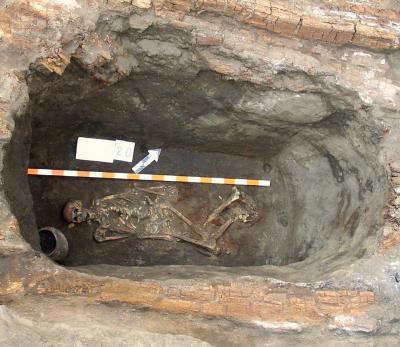It's no surprise that natural selection does not always take an evolutionary time scale.
When thousands of knights died during the Crusades at Acre, natural selection was being channeled. Yes, there were still other mechanisms of evolution but when the available pool of people is changed, positive selection is changed also. Pinpointing that on a time scale can be tough but there has been much research into the factors that have influenced the human genome since the end of the last Ice Age and a team of anthropologists, geneticists and archaeologists have analyzed ancient DNA from skeletons and found that selection has had a significant effect on the human genome even in the past 5,000 years.
For years population geneticists have been able to detect echoes of natural selection in the genomes of living humans, but those techniques are typically not very accurate about when that natural selection took place.
The new work involved analyzing DNA from archaeological skeletons and then comparing the prehistoric data with that of contemporary Europeans using computer simulations. Where the genetic changes could not be explained by the randomness of inheritance, the researchers were able to infer that positive selection played a role, i.e., that frequency of a certain mutation increased significantly in a given population.

A grave with an about 5,000-year-old skeleton from a kurgan of the Yamnaya culture near the town Kirovograd in Ukraine. The Kurgan was also one of the best villains of all time, in "The Highlander" film. Credit: Alla V. Nikolova
While investigating numerous genetic markers in archaeological and living individuals, first author Sandra Wilde of the Palaeogenetics Group at the
Johannes Gutenberg Universitaet Mainz
Institute of Anthropology noticed striking differences in genes associated with hair, skin, and eye pigmentation. "Prehistoric Europeans in the region we studied would have been consistently darker than their descendants today. This is particularly interesting as the darker phenotype seems to have been preferred by evolution over hundreds of thousands of years. All our early ancestors were more darkly pigmented."
However, things must have changed in the last 50,000 years as humans began to migrate to northern latitudes.
"In Europe we find a particularly wide range of genetic variation in terms of pigmentation," adds co-author Dr. Karola Kirsanow, a member of the Palaeogenetics Group at Mainz University. "However, we did not expect to find that natural selection had been favoring lighter pigmentation over the past few thousand years."
The signals of selection they have identified are comparable to those for malaria resistance and lactase persistence, meaning that they are among the most pronounced that have been discovered to date in the human genome.
The authors see several possible explanations.
"Perhaps the most obvious is that this is the result of adaptation to the reduced level of sunlight in northern latitudes," says corresponding author professor Mark Thomas of University College London. "Most people of the world make most of their vitamin D in their skin as a result UV exposure. But at northern latitudes and with dark skin, this would have been less efficient. If people weren't getting much vitamin D in their diet, then having lighter skin may have been the best option."
"But this vitamin D explanation seems less convincing when it comes to hair and eye color," Wilde continues. "Instead, it may be that lighter hair and eye color functioned as a signal indicating group affiliation, which in turn played a role in the selection of a partner." Sexual selection of this kind is common in animals and may also have been one of the driving forces behind human evolution over the past few millennia.
"We were expecting to find that changes in the human genome were the result of population dynamics, such as migration. In general we expect genetic changes due to natural selection to be the exception rather than the rule. At the same time, it cannot be denied that lactase persistence, i.e., the ability to digest the main sugar in milk as an adult, and pigmentation genes have been favored by natural selection to a surprising degree over the last 10,000 years or so," adds Professor Joachim Burger, senior author of the study. "But it should be kept in mind that our findings do not necessarily mean that everything selected for in the past is still beneficial today. The characteristics handed down as a result of sexual selection can be more often explained as the result of preference on the part of individuals or groups rather than adaptation to the environment."
Source: Johannes Gutenberg Universitaet Mainz




Comments